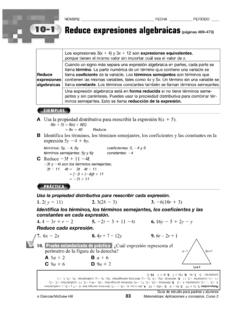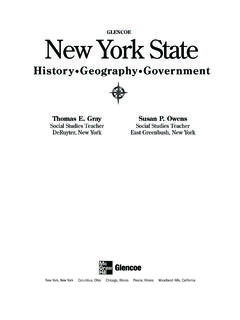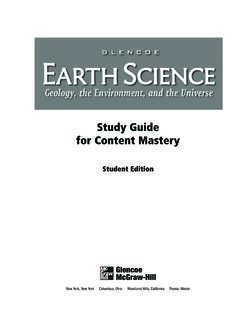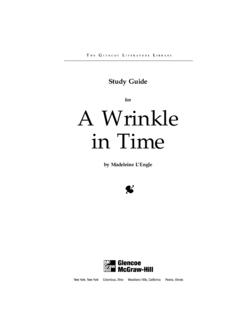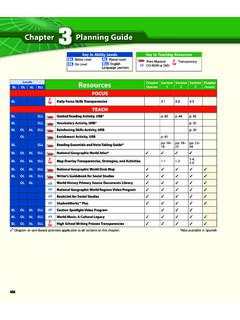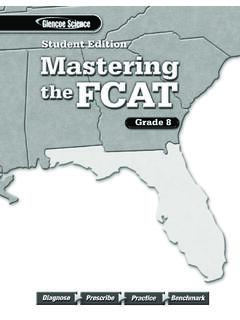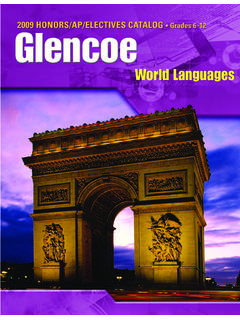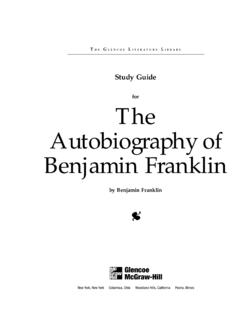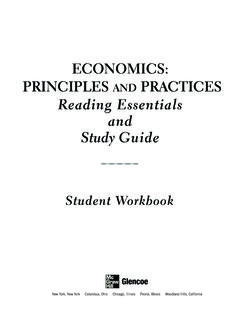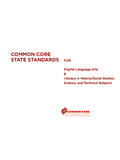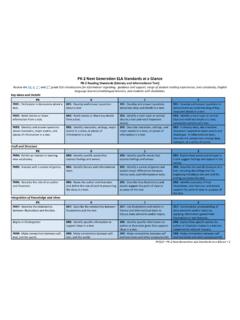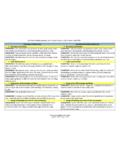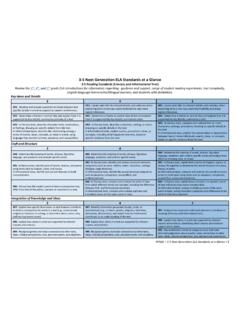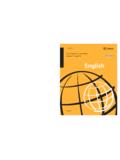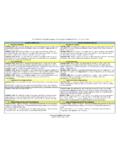Transcription of READING STRATEGIES AND LITERARY ELEMENTS
1 READING . STRATEGIES AND. LITERARY ELEMENTS . Contents Introduction to READING STRATEGIES and LITERARY ELEMENTS .. 3. LITERARY ELEMENTS Focus Lessons Lesson 1: ELEMENTS of Fiction .. 7. Lesson 2: Point of View I.. 9. Lesson 3: Point of View II .. 11. Lesson 4: Dialogue .. 13. Lesson 5: Flashback .. 15. Lesson 6: Foreshadowing.. 17. Lesson 7: Irony .. 19. Lesson 8: Style .. 21. Lesson 9: Tone .. 23. Lesson 10: Hyperbole.. 25. Lesson 11: Archetype .. 27. Lesson 12: Allusion .. 29. Lesson 13: Symbolism .. 31. Lesson 14: Figurative Language .. 33. Lesson 15: Imagery and Motif.. 35. Lesson 16: Mood .. 37. Lesson 17: Sound Devices .. 39. Lesson 18: Personification.. 41. READING Comprehension Exercises 1 5 .. 43. Focus Lessons Answer Key.. 77. Exercises Answer Key ..86. Exercises Answer Sheet ..87. This booklet was written by The Princeton Review, the nation's leader in test preparation. The Princeton Review helps millions of students every year prepare for standardized assessments of all kinds.
2 Through its association with Glencoe/McGraw- Hill, The Princeton Review offers the best way to help students excel on the North Carolina English I End-of-Course Test. The Princeton Review is not affiliated with Princeton University or Educational Testing Service. Grateful acknowledgment is given authors and publishers for permission to reprint the following copyrighted material. Every effort has been made to determine copyright owners. In case of omissions, the Publisher will be pleased to make suitable acknowledgments in future editions. Nothing Gold Can Stay by Robert Frost, from The Poetry of Robert Frost, edited by Edward Connery Lathem. Copyright 1923, 1928, 1930, 1934, 1939, 1947, 1969 by Holt Rinehart and Winston. Copyright 1936, 1942, 1945, 1951, 1956, 1958, 1962 by Robert Frost. Copyright 1964, 1967, 1970, 1973, 1975 by Lesley Frost Ballantine. Reprinted by permission of Henry Holt & Company, LLC. To An Aviator from Bright Harbor, by Daniel Whitehead Hicky.
3 Copyright 1932, 1960 by Daniel Whitehead Hicky. Reprinted by permission of Henry Holt & Company, LLC. Player Piano from The Carpentered Hen and Other Tame Creatures, by John Updike. Copyright 1954 by John Updike. Reprinted by permission of Random House, Inc. Excerpt from Out of Africa, by Isak Dinesen. Copyright 1937 by Random House. Reprinted by permission of Random House, Inc. Loaded for Raccoon from If You Can't Say Something Nice by Calvin Trillin. Copyright 1987 by Calvin Trillin. Reprinted by permission of Houghton Mifflin. Lost from The Complete Poems of Carl Sandburg, copyright 1950 by Carl Sandburg and renewed 1978 by Margaret Sandburg, Helga Sandburg Crile, and Janet Sandburg, reprinted by permission of Harcourt, Inc. Hockey by Scott Blaine. Reprinted by permission of Scholastic, Inc. Excerpt from My Family and Other Animals by Gerald M. Durrell. Copyright 1957, renewed 1985 by Gerald M. Durrell. Reprinted by permission of Viking Penguin, a division of Penguin Putnam, Inc.
4 A Man Told Me the Story of His Life from Later the Same Day by Grace Paley. Copyright 1985 by Grace Paley. Reprinted by permission of Farrar, Straus & Giroux, Inc. Everything Else Falls Away by Lee Smith, from Why I Write, edited by Will Blythe. Copyright 1998 by Will Blythe. Reprinted by permission of Little, Brown & Company. Glencoe/McGraw-Hill Copyright 2001 The McGraw-Hill Companies, Inc. All rights reserved. Permission is granted to reproduce material contained herein on the condition that such material be reproduced only for classroom use; and be provided to students, teachers, and families without charge; and be used solely in conjunction with Glencoe Literature or Writer's Choice. Any other reproduction, for use or sale, is prohibited without written permission of the publisher. Send all inquiries to: Glencoe/McGraw-Hill 8787 Orion Place Columbus, OH 43240-4027. P/N Printed in the United States of America 1 2 3 4 5 6 7 8 9 047 04 03 02 01 00.
5 Introduction to READING STRATEGIES and LITERARY ELEMENTS Overview of the North Carolina English I End-of-Course Test The English I exam is an End-of-Course Test administered to North Carolina students during the final days of the school year. End-of-Course Tests, which students first encounter in grade 9, take the place of End-of-Grade Tests, which are administered in grades 3 through 8. This exam includes two components: Editing and Textual Analysis. This booklet focuses only on preparation for the Textual Analysis section. When taking the English I Textual Analysis Test, students have 95 minutes to read 8 passages and answer 72 questions. The passages encompass LITERARY works (including short stories, fables, and poetry), essays, memoirs, book reviews, and biographical passages, along with informational articles on issues of common interest. They are grouped thematically, and questions frequently ask students to compare the themes or stylistic approaches of diverse passages.
6 The tests may undergo slight revisions, so make sure to consult your testing coordinator about specific information on the test this year. This End-of-Course Test directly corresponds with the North Carolina Standard Course of Study for ninth grade. This test is challenging because of its heavy emphasis on LITERARY ELEMENTS and terms. Students are expected to be familiar with all the LITERARY terms listed in the standards concepts such as mood, tone, style, metaphor, simile, alliteration, and hyperbole and to apply these in fairly sophisticated LITERARY analyses. In other words, these questions test not only general facility in READING , but also specific knowledge. To do well on the test, students need to be familiar with these terms. Copyright The McGraw-Hill Companies, Inc. Content of Booklet The READING STRATEGIES and LITERARY ELEMENTS booklet is composed of reproducible lessons and exercises. The focus lessons provide a focused way of introducing specific LITERARY concepts and READING STRATEGIES .
7 The exercises are directly modeled after the End-of-Grade Test. Each exercise contains two or three passages and a series of multiple-choice questions that test students' READING comprehension. You will need to make a photocopy of each lesson or exercise before distributing it to students. The transparencies cover selected terms and skills from the focus lessons. They provide an alternate means of introducing LITERARY concepts and READING STRATEGIES and can be used to supplement the focus lessons as well as the selections in Glencoe Literature. The next few pages will explore different ways to use these materials in your classroom. Introduction to READING STRATEGIES and LITERARY ELEMENTS Grade 9 3. How to Use the Lessons The focus lessons cover all the key LITERARY ELEMENTS and terms listed in the North Carolina Standard Course of Study for ninth grade. Assigning and reviewing the focus lessons will provide students with the knowledge they need to do well on the End-of-Course Test.
8 Each focus lesson defines a LITERARY element or group of LITERARY ELEMENTS , provides a READING passage that exemplifies these terms, and includes three to four open- ended questions that guide students toward a deeper understanding of the concept or concepts being taught. Each lesson is designed to be used as an in-class activity, to be completed in pairs or small groups. Students will find it easier to apply and understand concepts if they can discuss the answers with their peers. However, if you are pressed for time, you can distribute the focus lessons as homework assignments. You may want to assign the focus lessons before the multiple-choice exercises. This way, when students encounter LITERARY ELEMENTS in the exercises, they will have had prior exposure to them. You can also distribute lessons after the exercises as a means of targeting problem areas. For example, if most students have trouble with a question about mood, you can use the focus lesson about mood to strengthen their understanding.
9 Another idea is to match the lessons with selections in Glencoe Literature, The Reader's Choice. Each lesson provides references to pages in Glencoe Literature that highlight the subject of the lesson. Effective READING and Writing STRATEGIES Before distributing the first lesson, it might help to remind students to do the following: Copyright The McGraw-Hill Companies, Inc. Jot down notes in the margins of the passages and underline phrases that help them answer the questions. Write in full, clear sentences. Make specific textual references when answering the questions. Refer to specific paragraphs and quote phrases to support ideas. Answer keys for the focus lessons are located on pages 77 85. 4 Introduction to READING STRATEGIES and LITERARY ELEMENTS Grade 9. How to Use the READING Comprehension Exercises The READING Comprehension exercises include the same types of passages and questions that appear on the test. The exercises can be used over a short period for intensive test practice or can be spread throughout the year to supplement classroom activities.
10 When you first assign the exercises, you may want to give students unlimited time to complete them. However, to better simulate test conditions, you should eventually give students a 17 24 minute time limit (around minutes per question) on each exercise. You may also find it useful to distribute both scratch paper and a photocopy of a bubble sheet (located on pages 87 88). Explain to students that when they take the test, they will not be able to write on the test booklet. Students should get used to bubbling in answers and using scratch paper to jot notes and record the process of elimination. (See below for more on these methods.). Answer keys are located on page 86. If students have trouble with a specific term, you can use the focus lessons and the transparencies to deepen their understanding of the concept. General Test-Taking STRATEGIES The process of elimination is the key to success on all multiple-choice tests. This is particularly true for the English I End-of-Course Test, since the test is scored based on the number of questions that students answer correctly.
